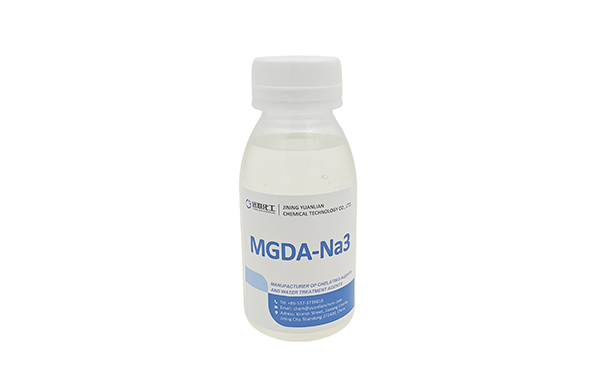
MGDA·Na3: The High-Performance, Eco-Conscious Chelator for Dishwasher Detergents
The selection of Methylglycine-N,N-diacetic acid, Trisodium Salt (MGDA·Na3) as the preferred chelator in dishwasher detergents is driven by a powerful combination of environmental, efficiency, safety, and compatibility benefits. Here is a detailed analysis from technical, application, and market trend perspectives.

I. Technical Superiority: High Chelation Power & Stability
-
Exceptional Chelation Capacity for Superior Scale Control
MGDA·Na3, with its nitrogen-oxygen donor groups, exhibits significantly higher stability constants for metal ions like Calcium (Ca²⁺), Magnesium (Mg²⁺), and Iron (Fe³⁺) compared to traditional natural chelators like sodium citrate (e.g., a chelation value of ~60 mg/g for Ca²⁺). It effectively prevents hard water ions from combining with carbonate to form scale, avoiding white spots on tableware and limescale buildup in dishwasher components. Its chelation stability excels, especially under high temperatures (≤100°C) and a wide alkaline pH range (2-13.5), making it ideal for the demanding conditions of the main wash cycle (55-65°C). -
Dual Action: Chelation & Dispersion
Beyond sequestration, MGDA·Na3 adsorbs onto micro-crystals of calcium carbonate, inhibiting crystal growth via steric hindrance. This keeps scale dispersed in the water in a loose form, preventing deposition. Comparative tests show that formulas with MGDA can reduce water spot residue on glassware by over 70% in water with 250 mg/kg hardness. -
High Compatibility with Formula Components
-
Synergy with Oxidants: It acts as a stabilizer for sodium percarbonate/perborate, suppressing metal-ion-catalyzed decomposition and boosting bleaching efficiency (e.g., improving tea/coffee stain removal by ~20%).
-
Enzyme Compatibility: Remains stable under alkaline conditions (pH 9-11) without compromising the activity of proteases and amylases, working synergistically to remove protein and starch-based soils (studies indicate a ~30% increase in the cleaning index for enzyme-containing formulas).
-
Low-Foaming Profile: Its inherent non-foaming nature prevents foam overflow during high-pressure spraying, ensuring optimal pump efficiency (reducing foam height by ~80% compared to anionic surfactants like LAS).
-
II. Environmental & Safety: Aligning with Green Trends
-
Biodegradability Outperforming Traditional Chelators
MGDA·Na3 meets the OECD 301D standard for ready biodegradability (>80% degradation in 28 days), far exceeding the persistent EDTA and NTA (a suspected carcinogen). Regulations like EU EC-03-16 explicitly restrict the use of EDTA/NTA in dishwasher detergents, making readily biodegradable, low-toxicity (Aquatic EC50 >100 mg/L) MGDA the compliant choice. -
Core of Phosphate-Free Formulas
Global "phosphate bans" (e.g., EU 2017 limit of <0.3g/standard dose) drive phosphate-free detergents. MGDA·Na3 is phosphate-free, preventing aquatic eutrophication, while its chelation power effectively substitutes sodium tripolyphosphate (STPP) to maintain cleaning performance. -
Food-Contact Grade Safety
Toxicological data confirms low oral toxicity (LD50 >2000 mg/kg) and minimal skin irritation, complying with food-grade detergent safety standards (like China's GB 14930.1), making it safe for direct contact with tableware without residue concerns.
III. Application Fit: Addressing Key Dishwasher Challenges
-
Tackling Stubborn Stains from Diverse Cuisines
For heavy grease, starch (rice), protein (egg), and tea stains common in various cooking styles, MGDA·Na3 enhances the saponification process under alkaline conditions by chelating Ca²⁺/Mg²⁺ ions and works synergistically with enzymes. Tests show dishwasher powders with MGDA achieve a high cleaning index (4.5/5) for mixed artificial soils, outperforming EDTA-based formulas. -
Protecting Tableware Materials
-
Glass Care: By complexing free alkali metal ions, MGDA·Na3 helps reduce "rainbow filming" (sodium silicate corrosion). Formulas with MGDA help maintain glass light transmittance above 95%.
-
Metal Protection: Its ability to chelate copper and silver ions helps prevent oxidation and tarnishing of metal utensils, performing better than sodium citrate which requires higher concentrations.
-
-
Versatility Across Product Forms
Suitable for various formats like powders, tablets, and liquids/gels:-
Powders/Tablets: Blends well with layered silicates, improving flowability and storage stability, preventing caking.
-
Liquids/Gels: High water solubility (allowing clear 55% content solutions) and compatibility with hydrotropes (e.g., sodium cumenesulfonate) ensure low-temperature stability, ideal for precise dosing in smart dishwashers.
-
IV. Market Drivers: Regulation & Consumer Demand
-
Regulatory Push: Standards like China's GB/T 39020-2020, which restricts NTA/EDTA in "Green Detergent" evaluations, position MGDA as a key compliant chelator.
-
Consumer Shift: Growing demand for "spot-free" drying and eco-safe products is driving sales of MGDA-containing dishwasher detergents.
-
Cost Optimization: While its unit price is higher than sodium citrate, its high efficiency allows for reduced dosage (e.g., 0.5-2% can meet soft water needs), making the total formulation cost competitive.
Conclusion
MGDA·Na3, with its triple advantage of "high performance, environmental friendliness, and safe compatibility," stands as the "green core" of modern dishwasher detergents. Its precise alignment with challenges like hard water, diverse food soils, and stringent environmental regulations makes it not just a technical upgrade but an essential component for the industry's sustainable transformation. As phosphate-free, concentrated, and multi-functional formulas become mainstream, MGDA·Na3 is poised to expand its market share, leading dishwasher detergents into a new era of "Green Cleaning."
Yuanlian Chemical specializes in the production of polyaspartic acid (PASP),tetrasodium iminodisuccinate(IDS), GLDA, MGDA etc. with stable quality and excellent quantity!





Contact us